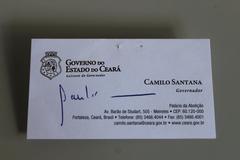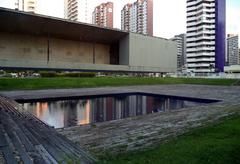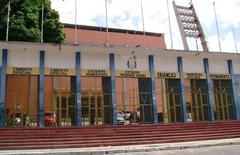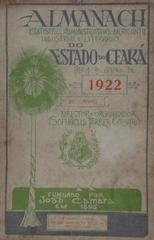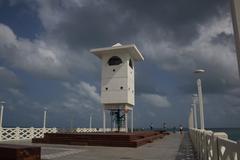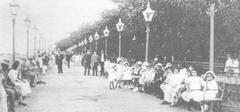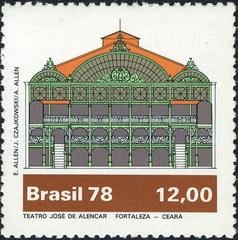
Comprehensive Guide to Visiting Fortaleza, Ceará, Brazil
Date: 13/08/2024
Captivating Introduction
Olá, fellow adventurers! Did you know Fortaleza boasts 34 kilometers of sun-kissed coastline and is a paradise for beach lovers? Imagine a city where history meets modernity in a vibrant dance of culture and growth. Picture yourself strolling along endless sandy beaches, savoring the taste of freshly caught seafood, and immersing yourself in a vibrant culture that pulses with energy and warmth. Fortaleza isn’t just a destination; it’s an experience waiting to be lived. Ready to dive into the heart of this enchanting city, where every street corner has a story, and every wave whispers secrets of the sea? Let’s embark on a journey through time and uncover the secrets of Fortaleza, Ceará’s not-so-hidden gem! (Two Soles Abroad, Wikipedia).
Fortaleza’s story begins with the daring adventurers like Pero Coelho de Souza, who set sail into the unknown in the early 1600s and established the Fort of São Tiago. This modest fort blossomed into one of Brazil’s largest cities, a place where every street and building whispers tales of adventure, conflict, and transformation (Wikipedia). The city’s transformation from a small Portuguese fort to a vibrant metropolis is a testament to its strategic and economic significance. With its rich history, cultural landmarks, and modern amenities, Fortaleza is a dynamic destination waiting to be discovered.
Table of Contents
- Unveiling Fortaleza: A Hidden Gem Through the Ages
- Top Attractions in Fortaleza, Ceará, Brazil
- Discovering Fortaleza: Your Ultimate Travel Guide to Ceará’s Gem
- Introduction
- Best Time to Visit
- Getting Around
- Currency and Payments
- Language
- Local Secrets and Hidden Gems
- Sensory Descriptions
- Interactive Elements
- Cultural Context and Etiquette
- Practical Information with a Twist
- Pop Culture References
- Time-Based Itineraries
- Local Lingo Lessons
- Seasonal Highlights
- Myth Busting and Surprises
- Storytelling Elements
- FAQ
- Call to Action
Unveiling Fortaleza: A Hidden Gem Through the Ages
Introduction
Welcome to Fortaleza, where history meets modernity in a vibrant dance of culture and growth! Imagine a city that evolved from a modest fort into Brazil’s fourth-largest metropolis, a place where every street and building whispers tales of adventure, conflict, and transformation. Ready to embark on a journey through time and uncover the secrets of Fortaleza? Let’s dive in!
Colonial Period
Ever wondered how a tiny Portuguese fort blossomed into one of Brazil’s largest cities? Fortaleza’s story begins with the daring adventurers like Pero Coelho de Souza, who set sail into the unknown in the early 1600s. In 1603, they established the Fort of São Tiago, dubbing the settlement Nova Lisboa (New Lisbon). Picture this: the foundation of a city that would become a bustling metropolis! (Wikipedia).
By 1612, after the French were shown the exit, Martins Soares Moreno transformed the fort into Forte de São Sebastião. This reinforced stronghold became the region’s defender against invaders and local resistance (Wikipedia).
Dutch Occupation
The Dutch, ever the dramatists, arrived in 1630 with grand plans for the Brazilian Northeast. By 1637, they had captured the Fort of São Sebastião. Captain Matthias Beck of the Dutch West Indies Company constructed a stylish new fortress by the Pajeú River, Fort Schoonenborch—meaning ‘graceful stronghold.’ It officially opened on August 19, 1649 (Wikipedia).
However, the Dutch stay was brief. After losing Pernambuco in 1654, they handed over Fort Schoonenborch to the Portuguese, who, in a clever rebranding move, renamed it Fortaleza da Nossa Senhora de Assunção. This name eventually inspired the city’s own moniker (Wikipedia).
Establishment as a Village and Capital
By 1726, Fortaleza had graduated to an official village. Its prime location earned it the title of capital of Ceará state in 1799. This marked the dawn of Fortaleza’s journey from a modest settlement to a vibrant urban center (Wikipedia).
Imperial Period
The 19th century was Fortaleza’s glow-up era. It emerged as a major cotton export center, attracting European businesses. This boom necessitated the construction of a customs building in 1812. By 1824, Fortaleza was a political hotspot during the Confederation of the Equator, a movement for greater autonomy in northeastern Brazil. Though the revolution fizzled out, it spotlighted Fortaleza’s rising political and economic influence (Wikipedia).
Republican Period
Leap into the early 20th century, and Fortaleza is expanding rapidly. New districts such as Messejana and Porangaba popped up in the 1930s. The city also celebrated the establishment of its first university, the Universidade Federal do Ceará (UFC), in 1954 (Wikipedia).
By 1983, Fortaleza had begun integrating Maracanaú into its metropolitan area. By the 1980s, it had surpassed Recife to become the second most populous city in Northeastern Brazil, boasting 2,571,896 residents (Wikipedia).
Modern Era
Today, Fortaleza stands as Brazil’s fourth-largest city, having outstripped Salvador in the 2022 census with over 2.4 million residents. It’s also the 12th largest city by GDP in Brazil (Wikipedia).
Fortaleza’s strategic location makes it a powerhouse for industry and commerce. As the closest Brazilian port to Europe—just 5,608 kilometers (3,485 miles) from Lisbon—it’s a vital gateway for trade and economic exchanges (Wikipedia).
Cultural and Architectural Landmarks
Fortaleza is a treasure trove of cultural and architectural marvels. The José de Alencar Theatre, a dazzling Art Nouveau masterpiece, is a must-visit. Then there’s the President Castelo Branco Mausoleum, honoring one of Ceará’s most distinguished figures, and Castelão Stadium, one of Brazil’s largest football arenas (Britannica).
The cityscape is a blend of wide boulevards and a bustling harbor. The breakwater at Mucuripe Point has transformed the harbor into a key export hub for sugar, cashews, lobsters, salt, cotton, carnauba wax, fruits, hides, textiles, and clothing (Britannica).
Transportation and Accessibility
Getting around Fortaleza is a breeze. The city is well-connected by highways and railways. The BR-116, Brazil’s main artery, starts here. The Baturité Railway links the city to fertile regions southwest and extends to Patos in Paraíba state. Fortaleza also boasts an international airport for easy access to other major cities (Britannica).
Choose Your Own Adventure: Itineraries
One-Day Wander: Start your day with a visit to the José de Alencar Theatre, followed by a stroll through the bustling Central Market. Grab lunch at a local eatery and spend your afternoon soaking up the sun at Praia de Iracema. Cap off your day with a sunset view from Mucuripe Point.
Weekend Explorer: Begin with the highlights of the One-Day Wander. On your second day, visit the Museum of Ceará and the Dragão do Mar Cultural Centre. Enjoy a night out in the vibrant Dragão do Mar area, known for its lively bars and restaurants.
Week-Long Expedition: Take your time exploring all the sites mentioned, and add a day trip to the beach town of Canoa Quebrada. Don’t miss the Fortaleza Cathedral and Coco Park for some local greenery. Savor the local cuisine, and maybe even catch a football match at Castelão Stadium.
Local Lingo Lessons
Want to blend in with the locals? Here are some key phrases and slang to get you started:
- Oi, tudo bem? (Hi, how are you?)
- Valeu! (Thanks!)
- E aí, beleza? (What’s up, cool?)
- Bora lá! (Let’s go!)
Try using these phrases and watch the smiles you’ll get in return!
Myth Busting and Surprises
Think you know Fortaleza? Think again! Here are a few surprising facts and common misconceptions about the city:
- Myth: Fortaleza is just another beach city. Reality: Beyond its stunning beaches, Fortaleza is a hub of culture, history, and commerce.
- Surprise: Fortaleza hosts one of the largest and most famous Carnival celebrations in Brazil, rivaling even Rio’s!
FAQ Section
Q: What is the best time to visit Fortaleza? A: The best time to visit is from August to December when the weather is warm and there’s little rainfall.
Q: Is Fortaleza safe for tourists? A: Like any major city, it’s important to stay aware of your surroundings. Stick to well-populated areas and avoid flashing valuables.
Q: What local dishes should I try? A: Don’t miss out on trying ‘moqueca’ (a Brazilian fish stew) and ‘acarajé’ (deep-fried balls of black-eyed pea dough).
Q: How do I get around the city? A: Fortaleza has a reliable bus system, and taxis and ride-sharing services are readily available.
Top Attractions in Fortaleza, Ceará, Brazil
Introduction
Welcome to Fortaleza, the sun-kissed jewel of Brazil’s northeastern coast! Picture yourself strolling along endless sandy beaches, savoring the taste of freshly caught seafood, and immersing yourself in a vibrant culture that pulses with energy and warmth. Fortaleza isn’t just a destination; it’s an experience waiting to be lived. Let’s dive into the heart of this enchanting city, where every street corner has a story, and every wave whispers secrets of the sea.
Praia do Futuro
Imagine the soothing sound of waves crashing against the shore as you lounge under a shady palm tree. That’s Praia do Futuro for you! Stretching over 7 kilometers, this beach is famous for its strong waves and pristine waters. Whether you’re a sun worshipper or an adrenaline junkie, Praia do Futuro has something for everyone. Don’t miss the vibrant barracas like Crocobeach and Chico do Caranguejo, where you can feast on mouthwatering seafood while enjoying live music. Pro tip: Try the local delicacy, caranguejo (crab), with a cold beer.
Dragão do Mar Center of Art and Culture
Step into a world where art meets history at the Dragão do Mar Center of Art and Culture. Named after the local abolitionist hero Francisco José do Nascimento, this cultural hub is a feast for the senses. Explore the planetarium, catch an indie film at the cinema, or wander through the Museum of Contemporary Art. The center often hosts exhibitions, theater performances, and concerts, making it a dynamic space for cultural immersion. Tip: Visit during the evenings when the lights create a magical atmosphere.
Mercado Central
Dive into the hustle and bustle of Fortaleza’s oldest market, the Mercado Central. Established in 1809, this market is a treasure trove of local handicrafts, spices, and foods. From intricate lacework to traditional Ceará hammocks, you’ll find unique souvenirs to take home. And if you’re a foodie, the local cheeses and sweets are a must-try! Insider tip: Bargaining is part of the fun, so channel your inner negotiator.
Fortaleza Cathedral
Marvel at the architectural grandeur of the Fortaleza Cathedral, also known as the Metropolitan Cathedral of St. Joseph. Completed in 1978 after nearly 40 years of construction, this neo-Gothic masterpiece can accommodate up to 5,000 worshippers. The stunning stained glass windows and towering spires make it a photographer’s dream. Fun fact: It’s the third-largest church in Brazil!
Beach Park
For a splash of adventure, head to Beach Park, located just 25 kilometers from Fortaleza. This is one of the largest water parks in Latin America, boasting thrilling water slides, wave pools, and lazy rivers. Perfect for families, the park also offers a resort and multiple dining options. Challenge: Brave the Insano, one of the tallest water slides in the world, if you dare!
Iracema Beach
Named after the character from José de Alencar’s novel, Iracema Beach is the heartbeat of Fortaleza’s nightlife. By day, it’s a serene spot for sunbathing and swimming. By night, it transforms into a lively hub with bars, restaurants, and nightclubs. Take a stroll down the Ponte dos Ingleses (English Bridge) at sunset for a breathtaking view. Secret spot: Look for the hidden murals depicting scenes from the novel.
José de Alencar Theater
Step back in time at the José de Alencar Theater, an architectural gem that opened in 1910. Named after the celebrated writer, this theater features a stunning blend of Art Nouveau and neoclassical styles. Catch a play, concert, or dance show, and don’t forget to explore the beautiful gardens. Hidden gem: The intricate ironwork and stained glass are perfect for Instagram-worthy photos.
Mucuripe Fish Market
Experience a slice of local life at the Mucuripe Fish Market. Located near Mucuripe Beach, this bustling market is where fishermen sell their daily catch. Buy fresh seafood and have it cooked on the spot at one of the nearby stalls. Early risers tip: Visit in the early morning to see the market at its liveliest.
Ceará Museum
Journey through time at the Ceará Museum, housed in a historic building from 1871. The museum showcases the rich history and culture of Ceará, with exhibits ranging from indigenous artifacts to colonial-era items. Don’t miss the collection of personal belongings from notable figures in the region’s history. Fun fact: The museum’s photo collection offers a fascinating glimpse into Fortaleza’s past.
Coco Park
Nature lovers, rejoice! Coco Park, or Parque Ecológico do Cocó, is one of the largest urban parks in Brazil, covering over 1,155 hectares. It’s a haven for bird watching, with numerous walking and cycling trails, picnic areas, and boat rides along the Cocó River. Challenge: Spot the rare Scarlet Ibis and share your sighting with the hashtag #CocoParkBirdWatching.
Practical Tips for Visitors
- Best Time to Visit: The dry season, from July to December, offers sunny and pleasant weather.
- Language: Portuguese is the official language. A few basic Portuguese phrases can go a long way.
- Currency: The Brazilian Real (BRL) is the local currency. While credit cards are widely accepted, carrying some cash is advisable.
- Safety: Stick to well-known tourist areas and avoid walking alone at night.
- Transportation: Public transportation is reliable, and ride-sharing apps like Uber are widely used.
Time-Based Itineraries
Morning: Start with a sunrise at Praia do Futuro, followed by breakfast at a local barraca. Afternoon: Explore Mercado Central for shopping and lunch. Visit the Dragão do Mar Center of Art and Culture. Evening: Head to Iracema Beach for dinner and nightlife, ending with a sunset view from Ponte dos Ingleses.
Call to Action
Ready to explore the hidden gems and vibrant culture of Fortaleza? Download the Audiala app for expert insights, interactive challenges, and personalized itineraries. Your adventure in Fortaleza awaits!
Discovering Fortaleza: Your Ultimate Travel Guide to Ceará’s Gem
Introduction
Olá, adventure seekers! Did you know Fortaleza boasts 34 kilometers of coastline, making it a paradise for beach lovers? Picture this: a place where the sun never takes a day off, the sea dances at your feet, and every corner holds a story waiting to be discovered. Welcome to Fortaleza, Ceará’s not-so-hidden gem! Ready to dive into the vibrant culture, tantalize your taste buds, and explore like a local? Buckle up as we embark on a journey through Fortaleza’s wonders, with a sprinkle of humor and a dash of insider secrets.
Best Time to Visit
Fortaleza is blessed with tropical weather year-round, but savvy travelers know the sweet spot is August to December. Think warm, sun-kissed days perfect for beach hopping and sightseeing without the hustle and bustle. Imagine sipping on a refreshing coconut water as you stroll along pristine beaches (Two Soles Abroad). Can you hear the waves calling your name? And if you visit in June, you might catch the vibrant Festas Juninas, a local festival celebrating traditional Brazilian culture with dance, music, and mouth-watering food.
Getting Around
Navigating Fortaleza is as easy as pie (or should we say pão de queijo?). Taxis and rideshare apps like Uber are yourgo-to for a smooth and safe ride. While public buses are a budget-friendly option, they can get crowded—so, for those moonlit journeys, stick to the trusty taxis or rideshares (Brazil City Guides). Pro tip: Make a game out of spotting the most colorful taxi! And don’t forget to take a ride on the jangadas, traditional fishing boats that offer a unique view of the coast.
Currency and Payments
In Fortaleza, the Brazilian Real (R$) holds the magic! Credit and debit cards are widely accepted, but keep some cash handy for those charming local markets and quaint eateries. ATMs are everywhere, but for peace of mind, use the ones in malls or banks (Brazil City Guides). Fun fact: Haggling in markets can turn into a delightful mini-adventure—give it a try! And if you’re visiting the Mercado Central, don’t miss out on artisanal crafts that make for perfect souvenirs.
Language
Portuguese is the heart and soul of Fortaleza! While English can get you by in touristy areas, learning a few Portuguese phrases will open doors and hearts. Try greeting with a cheerful “Olá!” or asking for directions with “Onde fica…?” You’ll find that a little effort goes a long way. And here’s a challenge: Try ordering a meal entirely in Portuguese! Here’s a head start: “Um prato de camarão, por favor” (One shrimp dish, please).
Local Secrets and Hidden Gems
Beyond the famous beaches, Fortaleza hides many treasures. Discover the artistic soul of the city in the Dragão do Mar Cultural Center, home to museums, cinemas, and theaters. Or dive into the local nightlife at Pirata Bar, famously open only on Mondays and known as “the craziest Monday night in the world.” And don’t miss the secret beach of Morro Branco, with its stunning cliffs and colorful sand dunes—truly a photographer’s dream.
Sensory Descriptions
Close your eyes and imagine the scent of fresh seafood grilling on a beachside stall, the sound of samba music filling the air, and the feeling of warm sand between your toes. The colors of Fortaleza are vibrant—think azure blues, emerald greens, and sunlit yellows. Taste the local delicacy, tapioca, a versatile dish that can be sweet or savory. And don’t forget to feel the rhythm of Forró, a traditional dance that tells stories with every step.
Interactive Elements
Ready for a challenge? Create your own Fortaleza scavenger hunt: Find a local artist’s mural, try a new fruit from the market, and take a photo with a jangada. Or embark on a mini-quest to find the best caipirinha in town—each bar claims to have the best, but only your taste buds can decide!
Cultural Context and Etiquette
In Fortaleza, warmth and friendliness are part of the culture. When greeting someone, a firm handshake with direct eye contact is customary. If you’re invited to someone’s home, bringing a small gift like flowers or chocolates is a nice gesture. And remember, punctuality is appreciated but arriving a little late is often considered fashionable!
Practical Information with a Twist
Need to know the essentials? Think of Fortaleza as a tropical wonderland where practicality meets paradise. Pack light, breathable clothing for the warm weather, but don’t forget a raincoat for those unexpected tropical showers. And here’s a rhyme to remember: “Sunscreen by day, bug spray by night—keep your travels sunny and bright!”
Pop Culture References
Fortaleza has made its mark in pop culture too. It’s the backdrop for several Brazilian telenovelas and inspired the song “Fortaleza” by Brazilian rock band Legião Urbana. Fans of Brazilian cinema might recognize scenes from the movie “Aquarius,” filmed along the picturesque coast.
Time-Based Itineraries
If you have only 24 hours in Fortaleza, start with a sunrise at Praia do Futuro, followed by a visit to the Central Market for some shopping. Enjoy a seafood lunch at a local restaurant, then spend the afternoon exploring the Dragão do Mar Cultural Center. Wrap up your day with a sunset at Ponte dos Ingleses and dinner at one of the beachside barracas.
For a longer stay, consider a themed journey: a food tour sampling local delicacies, a cultural trip exploring museums and historical sites, or an adventure itinerary with surfing and sand dune excursions.
Local Lingo Lessons
Here are some key phrases to get you started: “Bom dia!” (Good morning!), “Quanto custa?” (How much does it cost?), and “Obrigado” (Thank you - for men) or “Obrigada” (Thank you - for women). Pronunciation tip: Stress the second-to-last syllable in most words. And try using local slang like “massa” (cool) to impress your new friends.
Seasonal Highlights
Fortaleza transforms throughout the year with unique events and phenomena. In July, the city comes alive with the Fortal Carnival, an off-season celebration featuring parades, music, and dance. December brings the Ceará Music Festival, showcasing the best of Brazilian and international artists. And don’t miss the sea turtle nesting season from January to March, a magical time to witness hatchlings making their way to the ocean.
Myth Busting and Surprises
Think Fortaleza is just about beaches? Think again! The city is a hub for water sports like kitesurfing and windsurfing, thanks to its consistent winds. And did you know Fortaleza has one of the largest water parks in Latin America, Beach Park? It’s a thrill-seeker’s paradise with slides and attractions for all ages.
Storytelling Elements
Legend has it that Fortaleza’s name, which means “fortress,” comes from the Dutch fort Schoonenborch built in the 17th century. Over time, the fort changed hands between the Dutch and the Portuguese, each leaving their mark on the city’s architecture and culture. Another local tale speaks of the mysterious Pedra da Risca do Meio, an underwater rock formation that attracts divers from around the world, rumored to be the remains of a sunken city.
FAQ
- What is the best beach in Fortaleza? Praia do Futuro is a favorite for its clean sands and lively beach bars.
- Is Fortaleza safe for tourists? Like any major city, it’s important to stay vigilant. Stick to well-populated areas and avoid walking alone at night.
- What’s a must-try local dish? Don’t leave without tasting the famous moqueca, a delicious seafood stew.
- Can I use my credit card everywhere? Most places accept cards, but it’s handy to carry some cash for smaller vendors.
- Do I need to speak Portuguese? While many locals understand basic English, learning some Portuguese phrases will enhance your experience.
Call to Action
Ready to explore Fortaleza? Download the Audiala app for personalized recommendations, insider tips, and a seamless travel experience. With Audiala, your adventure in Fortaleza is just a tap away. Don’t miss out—start planning your dream trip today!
Call to Action
As our journey through Fortaleza comes to an end, it’s clear that this vibrant city is much more than just a beach destination. Fortaleza’s transformation from a tiny Portuguese fort into Brazil’s fourth-largest metropolis is a testament to its strategic and economic significance. Today, it stands as a vibrant urban center that seamlessly blends history, culture, and modernity (Wikipedia). From the bustling markets and historic landmarks to the serene beaches and lively nightlife, Fortaleza offers a unique blend of experiences that cater to every type of traveler. Whether you’re a history buff, a foodie, or an adventure seeker, Fortaleza has something special for you.
But don’t just take our word for it. Download the Audiala app and let it be your ultimate guide to unlocking Fortaleza’s hidden stories and secrets. With Audiala, you’ll have expert insights, interactive challenges, and personalized itineraries right at your fingertips. So, what are you waiting for? Start planning your dream trip to Fortaleza today and let the adventure begin!
References
- Wikipedia. (2024). Fortaleza. source url
- Two Soles Abroad. (2024). Top Attractions in Fortaleza. source url
- Brazil City Guides. (2024). Fortaleza Travel Guide. source url
- Crocobeach. (2024). Crocobeach Official Website. source url
- Chico do Caranguejo. (2024). Chico do Caranguejo Official Website. source url
- Dragão do Mar Center of Art and Culture. (2024). Dragão do Mar Official Website. source url
- Mercado Central. (2024). Mercado Central Official Website. source url
- Fortaleza Cathedral. (2024). Metropolitan Cathedral of St. Joseph Official Website. source url
- Beach Park. (2024). Beach Park Official Website. source url
- Ponte dos Ingleses. (2024). Ponte dos Ingleses TripAdvisor Page. source url
- José de Alencar Theater. (2024). José de Alencar Theater Official Website. source url
- Mucuripe Fish Market. (2024). Mucuripe Fish Market TripAdvisor Page. source url
- Ceará Museum. (2024). Ceará Museum Official Website. source url
- Coco Park. (2024). Coco Park TripAdvisor Page. source url












